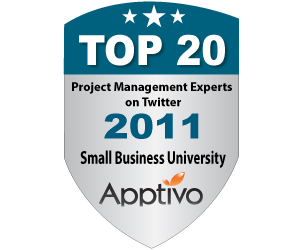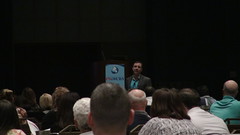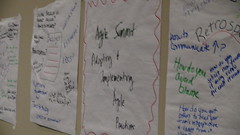Key points - as project managers, a structure needs to be created so that people can do the work. Dr. Terry challenged us NOT to identify the activities first and shared three flaws in activity based planning:
- The future is unknown (work can be defined and the project still fails)
- Activities are defined (plan flex is gained through contingencies)
- Activities are statements that lock orientation (so that when failure occurs, it is hard to think up alternate paths to success)
His fix to us is to approach the plan by asking questions vs. identifying activities. This opens up our orientation to different things and ways of thinking.
Okay, let me try this - or, rather he had us try this by having us (individually) write down some steps of a project we are working on. I am creating a new PM workshop for a client, so I wrote down:
- Identify need
- Identify what exists
- Collect requirements
- Create course map
- Build content
- Build exercises/case studies
- Run pilot
- Revamp
(Okay, not a great list, but we only had a few minutes.....)
Now to the new paradigm - write down the questions that each step answers:
- Why are we doing this training? What problem are we trying to solve?
- What do people already know? What other training/tools/processes exist to support the problem
- What do people need to know/do different/not do as a result of this training?
- How are we going to meet the need?
- What information to people need to know to meet the need?
- How can we ensure people can apply the knowledge?
- How well does our solution meet the need?
- How can it be even more effective?
Insight (and highlight too!) - By identifying activities first, it seems analogous to building a solution before requirements. We need to start with the "What?" (Questions 1 - 8) vs. the "How?" (Steps 1 - 8). This ensures that we are focusing on the real work that needs to be done - that if we first list our questions (what the intent of the project is about) and then take any template WBS (or start from scratch) to develop how we answer those questions, then we can arrive at a task list geared to the real need of the project. The What, not the How. Ask questions, then convert into activities.
Answered questions are yet another way to communicate status - in a way that our stakeholders can connect. Unanswered questions represent clear gaps in the project. And, these questions, like any template, are durable and reusable. Risk management is integrated in how the question is answered - low risk way to do it by thinking through question, alternatively, the medium and high risk approaches. Each question can also be analyzed for the level of risk it introduces to the project - perhaps breaking a question into more detail can help us better manage the risk!
My takeaway - Dr. Terry's "Critical Question Mapping & 'Organic PM'"
- Identify a Strategic problem/opportunity
- Brainstorm questions that need to be answered to solve problem or create opportunity
- Arrange in Categories (Project Phases!)
- Order/sequence with arrows
- Answer questions (by breaking into activities, doing work)
- Project complete!
My highlight - the quote he shared (source unknown) - "As I get older, passes me by." The < >; could be replaced with many other facets of our lives - don't let Project Management pass you by - integrating both Chuck and Dr. Terry's presentations - professional development is key - step back from how PM is being done and look at what questions you should be asking....or answering.












